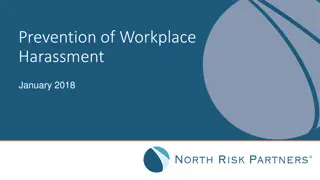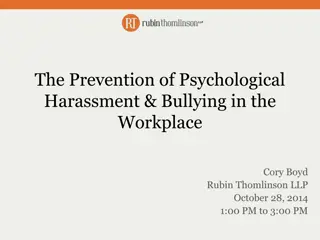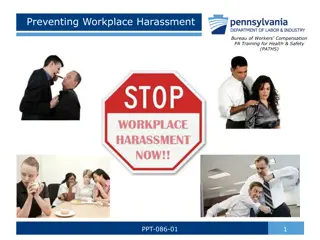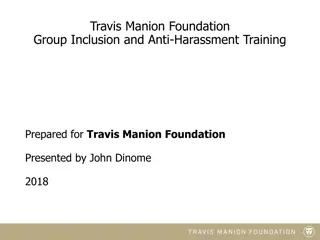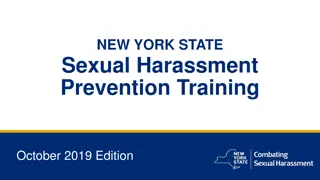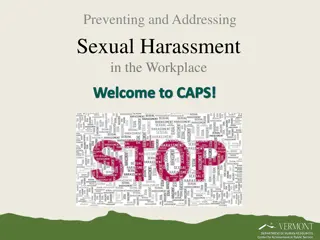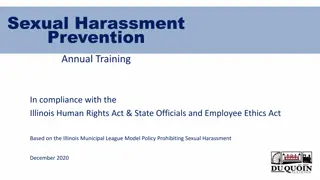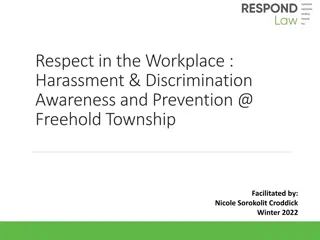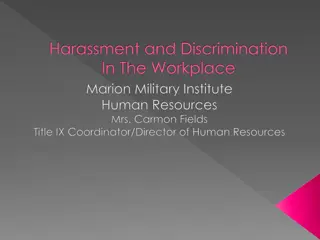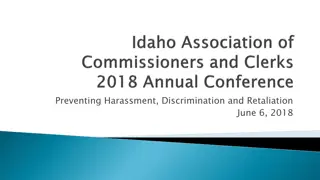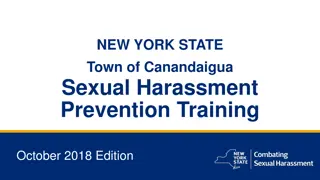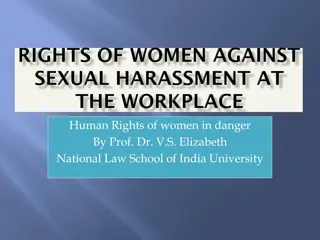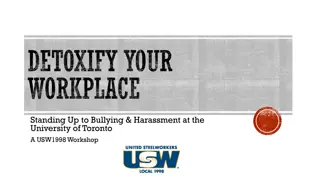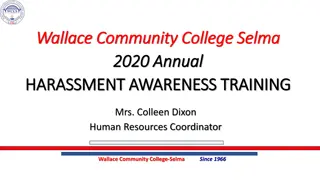Workplace Harassment and Discrimination Prevention Training for State Employees
State employees are required to comply with the Ethics Act to uphold fairness, honesty, and integrity in state government functions. The Human Rights Act prohibits discrimination and harassment based on protected classes like age, sex, race, religion, and more. It is crucial to understand and prevent harassment and discrimination in the workplace to create a safe and inclusive environment.
Download Presentation

Please find below an Image/Link to download the presentation.
The content on the website is provided AS IS for your information and personal use only. It may not be sold, licensed, or shared on other websites without obtaining consent from the author. Download presentation by click this link. If you encounter any issues during the download, it is possible that the publisher has removed the file from their server.
E N D
Presentation Transcript
Harassment & Discrimination Prevention Training
Harassment & Discrimination Are Prohibited As a state employee, you are subject to the Ethics Act, which is intended to ensure that the functions of State government are conducted with fairness, honesty, and integrity. Under the Ethics Act, you are prohibited from engaging in harassment or discrimination as defined by the Human Rights Act.
The Human Rights Act forbids discrimination and harassment on the basis of someone s actual or perceived membership in one or more of the following protected classes: Age Order of Protection Status Ancestry Pregnancy Citizenship Status Color Religion Disability Sex Race Sexual Orientation Marital Status Unfavorable discharge from the military Military Status National Origin
Sex. The status of being male or female. Id. at 1- 103(O). Marital Status. The legal status of being married, single, separated, divorced, or widowed. Id. at 1-103(J). National Origin. The place in which a person or one of his or her ancestors was born. Id. at 1-103(K). Pregnancy.Pregnancy, childbirth, or medical or common conditions related to pregnancy or childbirth. Id. at 1-103(L-5). Age.The chronological age of a person who is at least 40 years old. In the case of training and apprenticeship programs, age means a person who is 18 but not yet 40 years old. Id. at 1-103(A). Order of Protection Status. A person's status as being a person protected under an order of protection issued pursuant to certain statutes, or an order of protection issued by a court of another state. Id. at 1-103(K-5).
Religion. All aspects of religious observance and practice, as well as belief, unless an employer demonstrates that he or she is unable to reasonably accommodate an employee's or prospective employee's religious observance or practice without undue hardship on the conduct of the employer's business. Id. at 2-101(F). Sexual Orientation. The actual or perceived heterosexuality, homosexuality, bisexuality, or gender-related identity, whether or not traditionally associated with the person's designated sex at birth. Id. at 1-103(O-1). Unfavorable Military Discharge. Discharges from the Armed Forces of the U.S, their Reserve components, or any National Guard or Naval Militia which are classified as RE-3 or the equivalent, but does not include those characterized as RE-4 or "Dishonorable . Id. at 1- 103(P).
Military Status. A person's status on active duty in or status as a veteran of the armed forces of the U.S., status as a current member or veteran of any reserve component of the armed forces of the U.S., or status as a current member or veteran of the Illinois Army National Guard or Illinois Air National Guard. Id. at 1-103(J-1). Citizenship Status. The status of being: (1) a born U.S. citizen; (2) a naturalized U.S. citizen; (3) a U.S. national; or (4) a person born outside the U.S. and not a U.S. citizen who is not an unauthorized alien and who is protected from discrimination under a federal law. Id. at 2- 101(K). Disability. A determinable physical or mental characteristic of a person, including one that necessitates the person's use of a guide, hearing or support dog, the history of such characteristic, or the perception of such characteristic by the person complained against, which may result from disease, injury, congenital condition of birth or functional disorder and which characteristic is unrelated to the person s ability to perform the duties of a particular job or position. Id. at 1-103(I).
The Human Rights Act also prohibits other discriminatory acts in employment, including: prohibiting employees from speaking their native language, when unrelated to work duties certain immigration-related practices imposing conditions that would require an employee to violate a sincerely-held religious practice failure to offer employees reasonable accommodations related to pregnancy or childbirth and discrimination based on age in training and apprenticeship programs.775 ILCS 5/2-102.
Harassment Harassment means: any unwelcome conduct on the basis of an individual's actual or perceived race, color, religion, national origin, ancestry, age, sex, marital status, order of protection status, disability, military status, sexual orientation, pregnancy, unfavorable discharge from military service, or citizenship status that has the purpose or effect of substantially interfering with the individual's work performance or creating an intimidating, hostile, or offensive working environment. For purposes of this definition, the phrase "working environment" is not limited to a physical location an employee is assigned to perform his or her duties. Id. at 2-101(E-1).
Examples of conduct that could amount to harassment if based on a person s actual or perceived membership in one or more protected classes include: Offensive jokes Slurs Epithets or name calling Physical assault(s) Threats Intimidation, ridicule or mockery Insults or put-downs Offensive objects or pictures Deliberate touching, leaning over or cornering Offensive looks or gestures and/or Letters, telephone calls, personal e-mails, texts, or other materials of an offensive nature
Example Scenario One Employee A, a man who is Nigerian, recently started working at CSU. During his first week on the job, his coworkers start asking him questions about his African hair and mocking his accent. The coworker in the cubicle next to him mispronounces his name every day and then laughs. Employee A has been working at this agency for a month now and the conduct of his coworkers has only gotten worse. He feels very uncomfortable at work and dreads interacting with his coworkers.
This is an example of: A. Harassment based on gender B. Harassment based on race C. Harassment based on national origin D. Both B & C
The Correct Answer is D This is an example of harassment based on race and national origin because the unwelcome conduct is on the basis of Employee A s race and national origin and has the purpose or effect of creating an intimidating, hostile, or offensive working environment
Sexual Harassment is Prohibited The Ethics Act requires that: All persons have a right to work in an environment free from sexual harassment. All persons subject to this Act are prohibited from sexually harassing any person, regardless of any employment relationship or lack thereof. 5 ILCS 430/5-65(a) (emphasis added). Thus, engaging in sexual harassment is a violation of the Ethics Act, the Human Rights Act, and other laws and agency policies. See 775 ILCS 5/2-102(D). Under the Illinois Human Rights Act it is a civil rights violation [f]or any employer, employee, agent of any employer, employment agency or labor organization to engage in sexual harassment. 775 ILCS 5/2-102(D).
Definition of Sexual Harassment Under IHRA & the Ethics Act Under the Illinois Human Rights Act and Ethics Act, Sexual harassment means any unwelcome sexual advances, requests for sexual favors, or any conduct of a sexual nature when: submission to such conduct is made either explicitly or implicitly a term or condition of an individual s employment, submission to or rejection of such conduct by an individual is used as the basis for employment decisions affecting such individual, or such conduct has the purpose or effect of substantially interfering with an individual s work performance or creating an intimidating, hostile or offensive working environment
How Does CSU Define Sexual Harassment Under the New Title IX Regulations? Conduct on the basis of sex that is one or more of the following: Quid pro quo harassment: an employee conditioning an aid, benefit, or service of the institution on an individual s participation in unwelcome sexual conduct Hostile environment harassment: unwelcome conduct determined by a reasonable person to beso severe, pervasive, and objectively offensive that it effectively denies a person equal access to education Sexual assault, dating violence, domestic violence, or stalking
Harassment The same general principles of unwelcome conduct, severity, or pervasiveness, reasonableness, and hostile working/learning environment that constitute sexual harassment also apply to harassment based on sex, sexual orientation, and gender identity (actual or presumed), and any characteristic protected by law.
Types of Unlawful Sexual Harassment Quid Pro Quo Sexual Harassment. You do something for me, and I ll do something for you. This means that a manager or supervisor may not tell an employee that in order to receive a promotion, raise, preferred assignment, or other type of job benefit or to avoid something negative like discipline or an unpleasant assignment the employee must do something sexual in return. 1. Hostile Work Environment Sexual Harassment. The air at work is full of sexual references and it is impacting me. A hostile work environment may occur when unwelcome sexual advances, requests for sexual favors, or any conduct of a sexual nature has the purpose or effect of substantially interfering with an individual s work performance or creating an intimidating, hostile or offensive working environment. 2.
Unwelcome Behavior Sexual conduct becomes sexual harassment when the behavior is unwelcome. Behavior may be unwelcome in the sense that the victim did not solicit or invite it, or in the sense that the victim regarded the conduct as undesirable or offensive. Welcome behavior can quickly become unwelcome behavior. What starts off as welcome behavior (consensual joking) can cross a line and become unwelcome behavior. If someone states, Stop talking to me like this, then the unwelcome behavior must stop. Also, consent can be revoked at any time. The perpetrator cannot use as a defense Well you started it or you were ok with it at first.
Working Environment An employee s working environment is not limited to the physical location where the employee is assigned. The working environment extends to other work sites including off-site, mobile or moving work sites/locations. The prohibition that supervisors and co-workers not engage in sexual harassment now applies to nonemployees such as patrons, vendors, and service providers. Nonemployees can be victims of sexual harassment and/or perpetrators of sexual harassment.
Gender Identity, Sexual Orientation, and Third Parties (Bystanders) A person can be the victim of sexual harassment regardless of the victim s gender identity or the perpetrator s gender identity. A person can be the victim of sexual harassment regardless of the victim s sexual orientation or the perpetrator s sexual orientation. Victims of sexual harassment can include not only the target of the sexual harassment, but also third parties or bystanders.
Examples of Sexual Harassment Sexual harassment includes unwelcome conduct of a sexual nature (sexual advances and requests for sexual favors). Examples include: Pressure for sexual favors or to go out on a date Deliberate touching, leaning over, or cornering another person Sexual looks or gestures or whistling at someone Sending letters, telephone calls, e-mails, texts, or other materials of a sexual nature Sexual teasing, jokes, remarks, or questions Referring to another as a girl, hunk, doll, babe, honey, tootsie , etc. Actual or attempted rape or sexual assault
Examples (continued) More examples of conduct that may constitute sexual harassment include: Turning work discussions to sexual topics Asking about sexual fantasies, preferences, or history Sexual comments, sexual innuendos, or sexual stories Sexual comments about a person s clothing, body, or looks Kissing sounds, howling and smacking lips Telling lies or spreading rumors about a person s sex life Massaging neck, shoulders, etc. Touching another employee such as their clothing, hair, or body
Examples of Sexual Harassment in an Online Environment Our conduct online and through social media can constitute sexual harassment even when it occurs off the clock , off- site , or even out of state . Online sexual harassment includes using e-mail, cell phone texts, internet posting, online comments, blog posts, and social media (such as Facebook, Twitter, LinkedIn, Instagram, YouTube, and Snapchat) to send communications of a sexual nature. Examples include: Flirting and requests or demands to go on a date or have sex Sending inappropriate pictures or videos including sexually graphic material Using sexual language or comments including sexually offensive language Cyber stalking
Example Scenario Two Employer A supervises Employee B. Employer A tells Employee B that unless Employee B has sex with Employer A, Employee B will be terminated. This is an example of: A. Hostile work environment B. Quid pro quo sexual harassment C. Discrimination D. All of the above
The correct Answer is B. This is an example of quid pro quo sexual harassment because Employee B s submission to Employer A s unwelcome sexual advance is made a condition of employment.
Example Scenario Three Employee A is recently married and two months ago got back from the honeymoon. Since returning, Coworker B and Coworker C have been making sexual remarks about the honeymoon and asking personal questions. These comments occur almost on a daily basis and over time have gotten more graphic, and now Coworkers B and C are sending offensive pictures to Employee A s work email account. Employee A has started calling in sick and is missing deadlines because the comments and pictures are so upsetting.
This is an example of: A. Hostile work environment sexual harassment B. Quid pro quo sexual harassment C. Discrimination D. None of the above
The correct answer is A. This is an example of Hostile Work Environment Sexual Harassment. Here, the coworkers unwelcome conduct of a sexual nature is interfering with Employee A s work performance and creating an intimidating, hostile, or offensive working environment.
Definition of Discrimination Unlawful discrimination means: discrimination against a person because of his or her actual or perceived: race, color, religion, national origin, ancestry, age, sex, marital status, order of protection status, disability, military status, sexual orientation, pregnancy, or unfavorable discharge from military service . . . . 775 ILCS 5/1-103(Q).
Examples of Unlawful Discrimination Conduct may amount to unlawful discrimination if, based on a person s actual or perceived membership in one or more of the protected classes outlined above, an employer takes action involving: discharge recruitment discipline hiring tenure of terms promotion privileges and/or demotion other conditions of employment renewal of employment selection for training or apprenticeship
Unlawful Discrimination Unlawful discrimination occurs when an employer takes a discriminatory employment action because of an applicant s or employee s actual or perceived membership in one of the protected classes above. However, it does not prevent an employer from taking employment action for another reason unrelated to an applicant s or employee s membership in a protected class.
Is this an example of unlawful discrimination? Employee A is a pregnant woman who recently told her employer, Employer B, that she was expecting a child and her due date was seven months away. The following week, Employee A asked for time off to attend a doctor s appointment. Three weeks later, Employee A had another doctor s appointment and requested time off work. Two weeks later, Employer B had a meeting with Employee A and told her that the agency had decided to make her position part-time because of Employee A s condition . Employer B said this would be good for Employee A because now she could focus on her doctor s appointments and her health and not have to worry about working as many hours. Employee A is very upset by this because she wants a full-time position, and never told Employer B she wanted less hours or needed less hours because of her pregnancy.
Yes This is an example of unlawful discrimination because Employer B changed the conditions of Employee A s employment on the basis of her pregnancy.
Is this an example of unlawful discrimination? Employee A, who is a 50 year-old Muslim woman, has been late to work for several months. Employee A s supervisor, Employer B, knows Employee A is a 50 year-old Muslim woman. Last week, Employer B told Employee A she was being put on a corrective action plan because of her tardiness, and if she did not improve her employment would be terminated. In fact, a month earlier Employer B terminated Employee C, a 30 year-old Christian male because of his repetitive tardiness. Employee A continued to be late, in some cases over two hours late. Employer B terminated Employee A and informed her it was because her chronic tardiness was against office policy and prevented her from completing the required work on time.
No This is not an example of unlawful discrimination. Although Employee A is a member of several protected classes because she is over 40 years old, Muslim, and a woman, on these facts Employer B did not unlawfully discriminate against her. She was not discriminated against because she was terminated for violating office policy and not fulfilling the job duties, and not because of her age, religion, or sex. Furthermore, Employer B applied the same standard to another employee outside of Employee A s protected classes, who engaged in similar behavior.
How to Report Harassment, Sexual Harassment, & Discrimination Any employee who witnesses, is subjected to, or becomes aware of sexual harassment, harassment, and/or discrimination should immediately report the incident. You can report to: your employer or designated CSU reporting officer, the State of Illinois Sexual Harassment & Discrimination Helpline, the Office of Executive Inspector General ( OEIG ), and/or the Illinois Department of Human Rights ( IDHR ).
Reporting to Your Employer Report the incident to one or more of the following employer representatives: Your Supervisor or any member of management you trust. Supervisors and members of management are responsible for knowing the employer s internal complaint investigation and resolution process. 1. 2. Designed CSU Officers who will work to investigate and resolve harassment and discrimination complaints: Ethics Officer Robin Hawkins (773) 995-2462 Human Resources Officers (773) 995-2040 Title IX Coordinator Michelle Ozuruigbo (773) 995-2462 Dean of Students Office (773) 995-4510 or Academic Affairs (773) 995-2402
Reporting to the State of Illinois Helpline If you or someone you know has experienced or witnessed sexual harassment or discrimination in the workplace, please call the State of Illinois Sexual Harassment and Discrimination Helpline for assistance. Calls are confidential and can be made anonymously. Call: 1-877-236-7703 Visit https://www2.illinois.gov/sites/sexualharassment/Pages/default. aspx Helpline representatives can help callers navigate their numerous reporting options and share additional information related to counseling, legal assistance, and frequently asked questions.
Reporting to the Office of Executive Inspector General ( OEIG ) The OEIG is an independent executive branch State agency that works to ensure accountability in State government. The OEIG s jurisdiction includes executive branch agencies, officers, and employees (other than those under the Attorney General, Secretary of State, Comptroller, or Treasurer), the four regional transit boards, the State public universities, and approximately 300 boards and commissions, plus vendors doing business with those agencies and entities. The OEIG does not represent any party or agency in an investigation nor does it investigate on behalf of any individual or agency.
A complaint may be filed with the OEIG in writing, preferably on an OEIG complaint form, or orally. A complaint may be filed with the OEIG by: Completing a form online at http://www.inspectorgeneral.illinois.gov; Calling the OEIG s toll-free hotline at (866) 814-1113; Mailing a completed complaint form to: Office of Executive Inspector General for the Agencies of the Illinois Governor, Attention Complaint Division, 69 West Washington Street, Suite 3400, Chicago, Illinois 60602; Faxing a completed complaint form to (312) 814-5479; Contacting the OEIG by telecommunications device for the disabled (TTY) at (888) 261-2734; or Scheduling an appointment with its Springfield or Chicago locations. The OEIG may accept complaints that are filed anonymously.
Reporting to the Illinois Department of Human Rights (IDHR) The Illinois Department of Human Rights (IDHR) is a state agency responsible for enforcing the Illinois Human Rights Act, the state law which makes it illegal to engage in sexual harassment or retaliation. Individuals may file charges related to harassment, discrimination, and/or sexual harassment with IDHR. IDHR has jurisdiction (authority) to investigate employers who have 1 or more employees. To start the process, submit a Complainant Information Sheet to IDHR.
Reporting to IDHR To file a charge, call IDHR or visit them online: 1-800-662-3942 | www.ILLINOIS.GOV/DHR IDHR Offices Locations: Chicago. Office: 312-814-6200 | 866-740-3953 (TTY), 100 W Randolph St, Suite 10-100, Chicago, IL 60601 Springfield. Office: 217-785- 5100 | 866-740-3953 (TTY), 535 W. Jefferson, 1st Floor, Intake Unit, Springfield, IL 62702 Marion. Office: 618-993-7463 | 866-740-3953 (TTY), 2309 W Main St, Marion, IL 62959
Protection from Retaliation Retaliatory action means reprimand, discharge, suspension, demotion, denial of promotion or transfer, or change in the terms or conditions of employment of any State employee that occurs in retaliation for an employee s involvement in reporting harassment, discrimination, or sexual harassment or participating in investigations or other proceedings. If you experience retaliation after reporting harassment or discrimination, that conduct can be reported to your supervisor, ethics officer, the OEIG, and the IDHR in the same manner that sexual harassment, harassment, and discrimination are reported.
Protection from Retaliation Under the Ethics Act Ethics Act: An officer, member, State employee, or State agency shall not take any retaliatory action against a State employee because the State employee: (1) Discloses or threatens to disclose to a supervisor or to a public body an activity, policy, or practice of any officer, member, State agency, or other State employee that the State employee reasonably believes is in violation of a law, rule, or regulation. (2) Provides information to or testifies before any public body conducting an investigation, hearing, or inquiry into any violation of a law, rule, or regulation by any officer, member, State agency, or other State employee. (3) Assists or participates in a proceeding to enforce the Ethics Act provisions. 5 ILCS 430/15-10.
Protection from Retaliation Under the Ethics Act If retaliatory action occurs, the OEIG can investigate the matter and recommend discipline. An employee can also bring a lawsuit pursuant to the Ethics Act. Anyone who intentionally violates this prohibition on retaliation is guilty of a misdemeanor and is subject to discipline or discharge. Id. at 50-5(a), (f).
Protection from Retaliation Under the Whistleblower Act An employer may not retaliate against an employee for disclosing information to a government or law enforcement agency, where the employee has reasonable cause to believe that the information discloses a violation of a State or federal law, rule, or regulation. 740 ILCS 174/15(b). Further, an employer shall not retaliate against an employee for refusing to participate in an activity that would result in a violation of a State or federal law, rule, or regulation. Id. at 20. If an employer retaliates against an employee in violation of the Illinois Whistleblower Act, and the employee succeeds in a civil suit, the employee may receive relief necessary to make the employee whole, including reinstatement into their position, back pay with interest, and compensation for damages. Id. at 30
Protection from Retaliation Under the Illinois Human Rights Act It is a civil rights violation to retaliate against a person who opposes that which they reasonably and in good faith believe to be unlawful discrimination or sexual harassment. 775 ILCS 5/6-101(A). For example, it is unlawful for someone to retaliate against a person who filed a complaint, participated in an investigation, or testified regarding a matter under the Human Rights Act. Id.
Consequences for Sexual Harassment Violations It is a violation of the Ethics Act to engage in sexual harassment as defined by the Act. As an Ethics Act violation, there are specific penalties for the violation. Any person who violates the Ethics Act s prohibition on sexual harassment: may be fined up to $5,000 per offense; is subject to discipline or discharge; and may also have fines or penalties imposed by a State or federal agency or court. See 5 ILCS 430/50-5(g).


